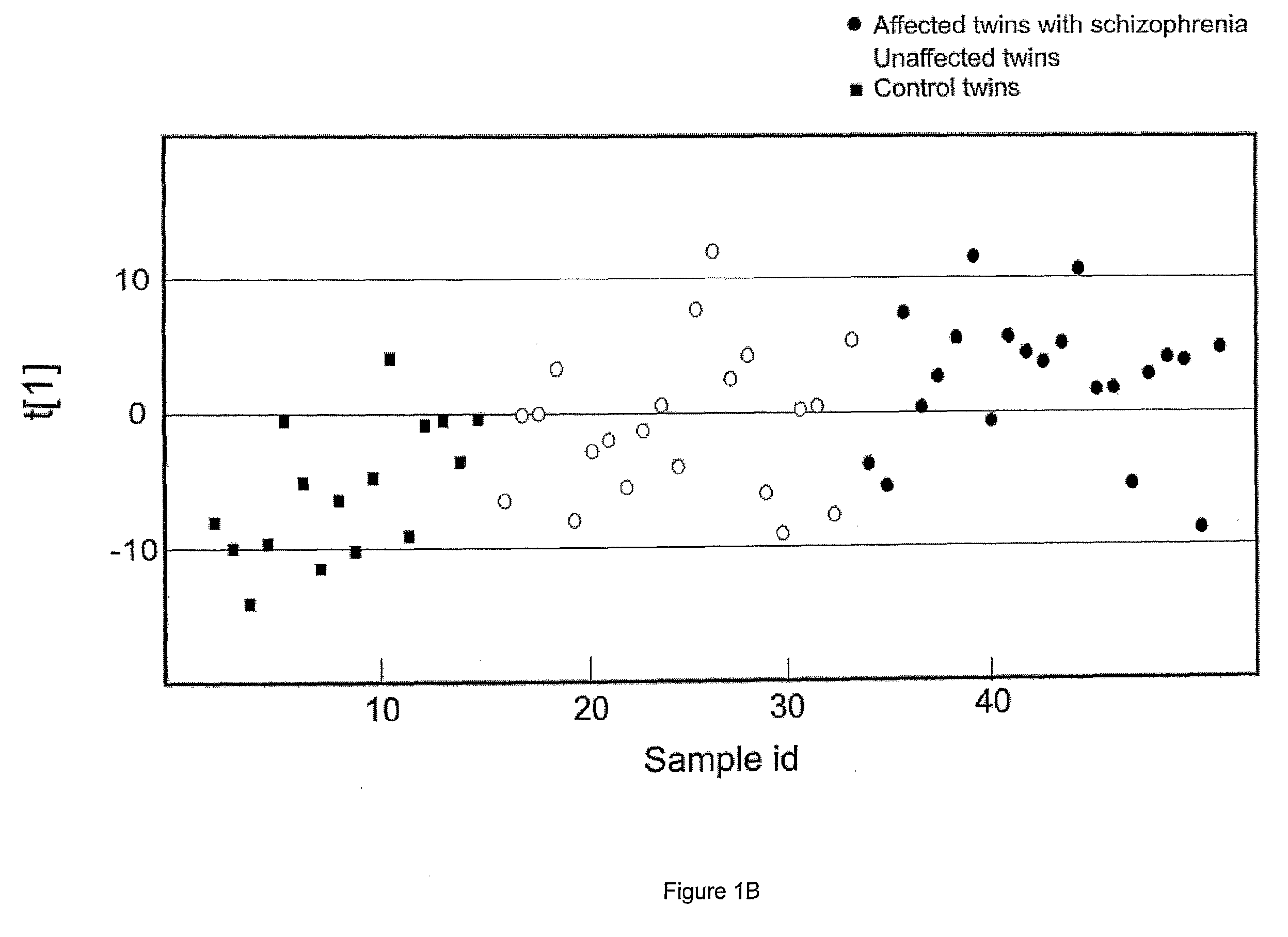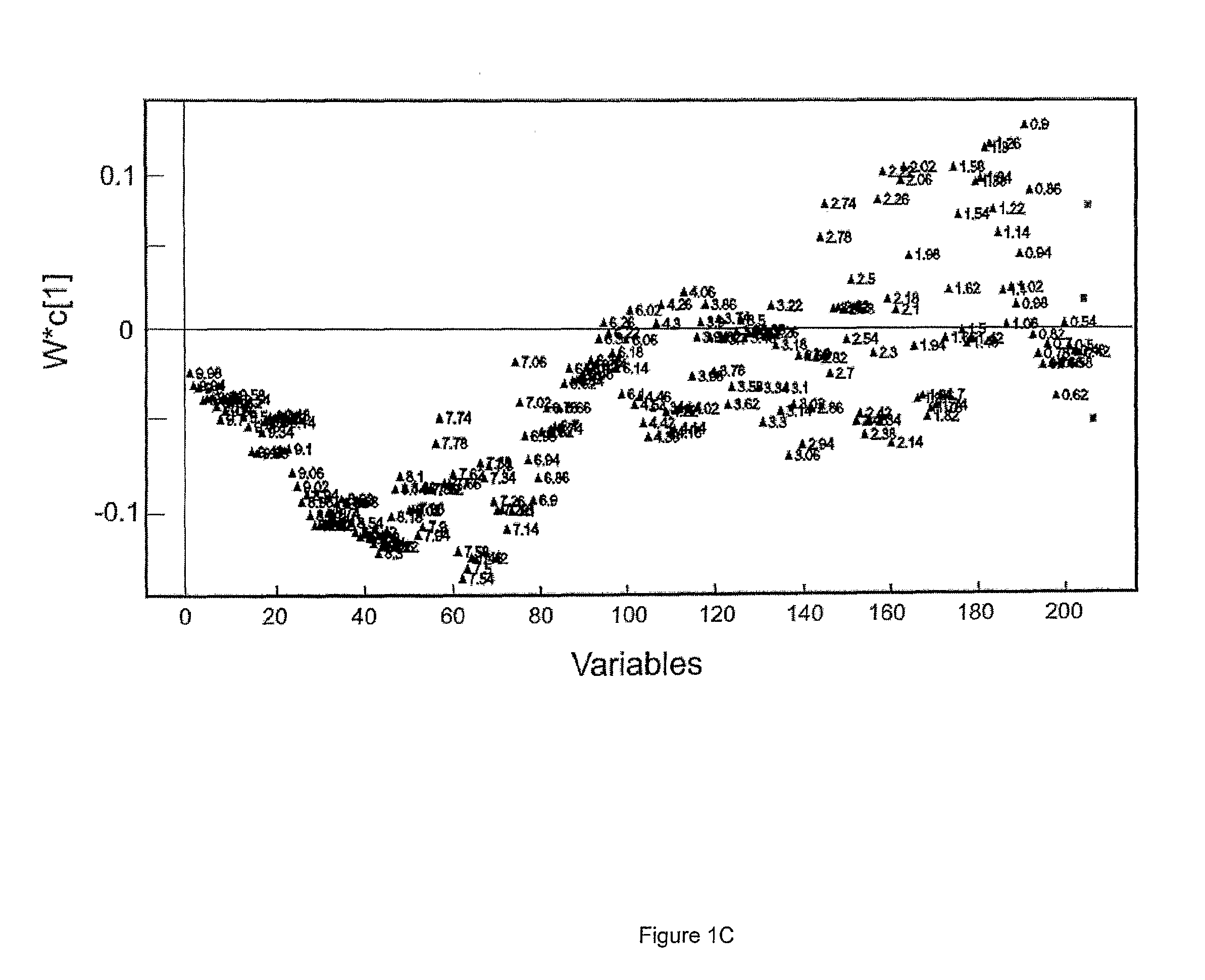Methods and Biomarkers for Diagnosing and Monitoring Psychotic Disorders
- Summary
- Abstract
- Description
- Claims
- Application Information
AI Technical Summary
Benefits of technology
Problems solved by technology
Method used
Image
Examples
example 1
Discussion of Example 1
[0236]The present study examined the metabolic plasma profiles of a total of 42 monozygotic twins discordant for schizophrenia and 16 matched control twins using 1H NMR in order to explore the role of genetic and environmental factors contributing to schizophrenia. The result show that signals from VLDL, LDL and aromatic regions are the most important factors differentiating ill and healthy co-twins discordant for schizophrenia from control twins. Interestingly, this differentiation was much more pronounced for female twins.
[0237]Overall, similar metabolic changes were observed in male and female schizophrenia twins, in the female group a potential predisposing disease signature was found in unaffected co-twins. This could imply a greater genetic loading for female twins. A marked sex difference in schizophrenia is a well established fact; female schizophrenia patients have, on average, a later age of onset and better prognosis. This has been attributed to pro...
example 2
Discussion of Example 2
[0256]Initial analysis of SELDI spectra of a total of 81 CSF samples (41 schizophrenia; 40 controls) showed a differential distribution of samples from drug-naïve patients with first onset paranoid schizophrenia away from healthy volunteer samples (FIGS. 5B, 5C and 5D). The protein / peptide profile of CSF was found to be characteristically altered in paranoid schizophrenia patients and a key alteration was the down-regulation of transthyretin around 14 kDa. These schizophrenia specific protein / peptide changes were replicated / validated in an independent sample set (n=58) using identical conditions (FIG. 8). Both experiments achieved an astonishingly high specificity (rate of true negative) of 95 / 98% and a sensitivity of 80 / 90%, respectively (Table 7). This means that virtually no control samples clustered with the schizophrenia group (FIGS. 5B and 5C). For a high diagnostic validity and consequent therapeutic interventions an accurate identification of those ind...
example 3
Clinical Samples
[0259]The protocols of this study including procedures for sample collection and analysis were approved by ethical committees. Informed consent was given in writing by all participants and clinical investigations were conducted according to the principles expressed in the Declaration of Helsinki. CSF and serum samples were collected from drug-naïve patients diagnosed with first episode paranoid schizophrenia or brief psychotic disorder due to duration of illness (DSM-IV 295.30 or 298.8; n=41 for CSF; n=35 for serum; Table 8) and from demographically matched healthy volunteers (n=40 for CSF; n=63 for serum; Table 8).
[0260]For post-mortem studies, fresh-frozen prefrontal cortex tissue (Brodmann area 9; 8 schizophrenia and 8 well matched control individuals) and liver samples (15 schizophrenia and 15 well matched controls) were obtained. The demographic details are listed in Table 8.
[0261]For red blood cell (RBC) experiments, a total of 40 blood samples (7 first-onset, ...
PUM
 Login to View More
Login to View More Abstract
Description
Claims
Application Information
 Login to View More
Login to View More - R&D
- Intellectual Property
- Life Sciences
- Materials
- Tech Scout
- Unparalleled Data Quality
- Higher Quality Content
- 60% Fewer Hallucinations
Browse by: Latest US Patents, China's latest patents, Technical Efficacy Thesaurus, Application Domain, Technology Topic, Popular Technical Reports.
© 2025 PatSnap. All rights reserved.Legal|Privacy policy|Modern Slavery Act Transparency Statement|Sitemap|About US| Contact US: help@patsnap.com



